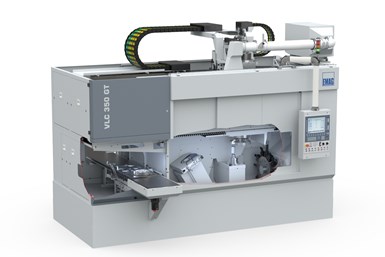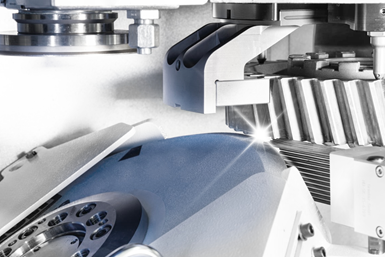Automated Hard Turning, Grinding on One Platform
This inverted vertical turning machine can perform hard turning and grinding of chucked components such as gears while loading and unloading material and completed parts itself.

This combined hard-turning/grinding machine is available with an internal grinding spindle mounted on a B axis to enable tapers to be ground.
Photo Credit: All photos courtesy of Emag LLCThe inverted vertical turning machine platform has been offered by Emag since 1992 with its VSC 250. This design is unique in that the spindle is able to load and unload parts itself. In a sense, it serves as its own robot.
Since then, the company has expanded its offerings creating modular designs that can be customized per a specific application. Its latest is the VLC 350 GT which is designed to perform hard turning and grinding of chucked components, especially for transmission and engine production applications. This enables parts such as gears to be completed in one setup.
The machine chucks components ranging up to 350 mm in diameter, performing turning and grinding processes progressively in a single clamping. The VLC 350 GT enables traditional hard machining of gears, from hard turning of end faces and pre-turning of the bored holes and outer synchronizing taper through to finish grinding of those contours.
The internal grinding spindle with NC swiveling B axis allows for processing of components with internal tapers. The operations for a typical component with an internal taper include:
- Loading (and subsequent unloading) with a pickup spindle followed by hard turning of the end faces.
- Depending on the component geometry, inner contours (with one or two tapers), a cylindrical bored hole and the outer synchronizing taper can be pre-turned in the second step.
- The use of a cylindrical grinding element on the swiveling NC axis next makes it possible to machine various internal taper angles. To do this, the grinding spindle is swiveled precisely to the required angle for the specific case. Any required bored holes are also completed this way (with a zero-degree grinding angle).
- The final step is the grinding of the outer synchronizing taper with the external grinding spindle.

An external grinding spindle with integrated balancing system can be mounted straight or at an angle and can accept a grinding wheel measuring 400 mm in diameter.
Parts can be presented to the spindle at the pickup station via a conveyor belt or shuttle system. The spindle, which moves by way of an X-axis cross slide, then delivers the part to the machining area. A tool turret can be fitted with live tooling to perform drilling or milling operations. An available internal grinding spindle uses an HSK interface, while an available external grinding spindle with integrated balancing system can be mounted straight or at an angle and can accept a grinding wheel measuring 400 mm in diameter. Wheel reconditioning is performed using a rotary diamond dresser. A part gaging system is located outside the machining area to protect it from coolant and chips.
The VLC 350 GT is available in a variety of configurations. This includes one internal grinding spindle and a turret; two internal grinding spindles and a turret; one external grinding spindle and two internal grinding spindles; one external grinding spindle and a turret; and a honing unit, internal grinding spindle and turret.
For process control, this machine includes acoustic sensors for the grinding wheel and the dressing wheel. For the latter, this is especially helpful when dressing cubic boron nitride (CBN) and other very hard wheel materials to limit the amount of costly material removed during dressing.
Additional information and component application examples are found at gbm.media/emagvtl.
Related Content
Automation Idea for Halloween?
Maybe not. But, the candy-throwing robots at MetalQuest’s Nebraska facility do enable the contract machine shop to stand out at career fairs and similar events.
Read MoreTips for Troubleshooting and Repairing Chip Conveyors
A nonfunctioning chip conveyor can cause a high-production machine to be down for an extended period of time. Here is some troubleshooting advice if you’re having issues with your chip conveyors.
Read MoreReinventing the Wheel with Robot-Automated CNC Multitasking
One race team discovers how to efficiently manufacture a new wheel nut design for the next-generation NASCAR stock car with the help of a CNC mill/turn and a built-in robot.
Read MoreReplace Repetitive Measurement With DIY Robotic Automation
After minimal training, a shop can learn how to use this robotic inspection system configured for a shopfloor application to supersede repetitive, time-consuming, high-mix gaging processes. It can then be redeployed for another application somewhere else in the facility.
Read MoreRead Next
Do You Have Single Points of Failure?
Plans need to be in place before a catastrophic event occurs.
Read MoreEmerging Leaders Nominations Now Open
Here’s your chance to highlight a young person in your manufacturing business who is on the path to be a future leader moving your company forward.
Read More5 Aspects of PMTS I Appreciate
The three-day edition of the 2025 Precision Machining Technology Show kicks off at the start of April. I’ll be there, and here are some reasons why.
Read More







.jpg;maxWidth=300;quality=90)














